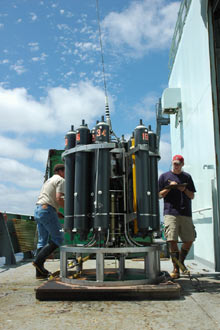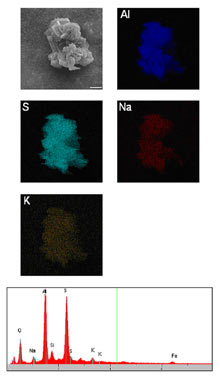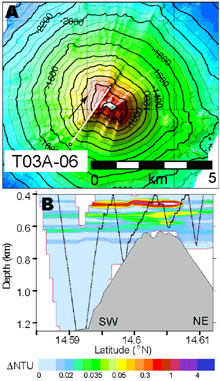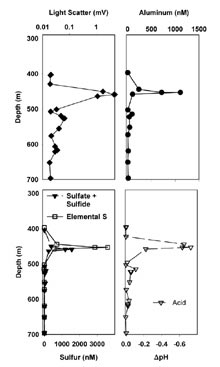
Geoff LeBon (left) and Nathan Buck retrieve and document water samples from the CTD (an instrument that measures conductivity, temperature, and depth). Click image for larger view and more details.
These images represent aspects of a towed hydrocast (tow-yo) at NW Rota-1 submarine volcano, located at 14° 36' N. The tow-yo was performed February 12, 2003. A) The bathymetric map shows (in white) the tow line of hydrocast. B) The hydrothermal plume above volcano shown as delineated by optical backscatter. The black saw-tooth pattern is the track of the CTD-rosette package as it passed over the volcano. The stair-step features in the track as are the locations where samples were taken. Click image for larger view and more details.
Hydrothermal Plumes and Prospecting
Joe Resing
Chemical Oceanographer
Joint Institute for the Study of the Atmosphere and Ocean, University of Washington
NOAA Vents Program, Pacific Marine Environmental Laboratory
The cooling magma (fluid which cools to form igneous rock) at the sea-floor hydrothermal sites heats the cold seawater in deep cracks. As the water is heated, it becomes buoyant and rises to the sea floor. Instead of forming a warm "pond" at the volcano surface, like that observed at Yellowstone Park, the hot fluid continues to rise into the cold ocean like smoke from a smokestack. As it rises, cold seawater mixes with the hydrothermal waters, which dilutes the fluids and increases their volume by as much as 10,000 times, creating a large plume of water. The fluids generally stop rising within 300 m (about 1,000 ft) of the top of the volcano, and they are dispersed by local currents.
Although sea-floor hydrothermal sites on ridges and arcs are likely numerous, the active discharge orifices themselves are small, scattered, and difficult to find. The chance of successfully finding these sites is greatly increased by searching first for the plumes emitted from the vents and not by searching for the vents themselves. Like smoke, the chemicals present in hydrothermal fluids form fine particles that can be seen using light and a light-sensitive sensor. Just as a trail of wind-blown smoke draws the eye to a smokestack, maps of hydrothermal plumes can lead oceanographers back towards a field of vents.
Tools of the trade
In their studies, oceanographers around the world rely on a basic tool: a conductivity-temperature-depth (CTD) package with optical and chemical sensors. This package also contains sampling bottles that can be closed on demand. The package can be lowered vertically to the sea-floor while the research ship holds position, gathering data and collecting samples throughout the water column. A more effective strategy for plume hunting is a "tow-yo," where the instrument package is continually raised and lowered above the volcano while the ship steams slowly ahead. This allows investigators to determine more precisely the shape of a hydrothermal plume and thus the location of its source on the sea floor.
Once plume studies detect and localize active venting, researchers use specialized sea-floor exploration tools to find the actual vents and associated biological communities. Such tools include camera sleds, remotely operated vehicles (ROVs), autonomous underwater vehicles (AUVs), and occupied submersibles (such as Alvin). These vehicles are used to create detailed maps of the vent fields and collect biological, geological, and chemical samples from the sea floor itself.
Chemistry of plume waters
The water that is heated by magma below the sea floor reacts with volcanic rocks resulting in fluids rich in dissolved minerals. The chemistry of these fluids is often different between vents at the same volcano and is often different for vents within tens of meters of each other. As the hot fluids escape the sea floor they rise up and form hydrothermal plumes, as discussed above. The plumes mix both with local cold seawater and with fluids from other nearby hydrothermal vents. The plume waters are chemically analyzed for many different dissolved and particulate chemical species. Samples collected from plumes formed above volcanoes enable us to identify the chemistry of a hydrothermal system without directly sampling the fluids as they exit the sea floor.

A scanning electron microscope (SEM) image and an elemental map of an alunite (a mineral) crystal found in the hydrothermal plume above NW Rota-1 volcano. The upper left box is the image. The remaining boxes are elemental maps of the elements indicated. The graph at the bottom of the image is a spot x-ray analysis of the particle. (Al stands for aluminum, Na is sodium, K is potassium, and S is sulfur.) Click image for larger view and image credit.
The chemistry that we observe in the vented fluids and plumes is indicative of the types of hydrothermal activity taking place beneath the sea floor. Our past exploration of the Mariana arc submarine volcanoes demonstrates that the chemical makeup of hydrothermal fluids on this arc exhibits more diversity than seen along most of the world's mid-ocean ridge system.
One exciting example of the novel chemistry that we have observed is found at NW Rota-1. At this volcano, the chemistry is dominated by sulfuric acid. This acid formed when volcanic gasses reacted with seawater to form sulfuric acid. The sulfuric acid rapidly dissolves volcanic rock. This results in fluid chemistries unlike those seen at mid-ocean ridges. This is evident in the plume chemistry. This chemistry is similar to that from volcanoes thought to produce mineral ores rich in gold. Further evidence for this is the presence of a mineral in the plume called alunite. It appears that this volcano has the right chemical makeup to produce commercially important ore deposits.





























